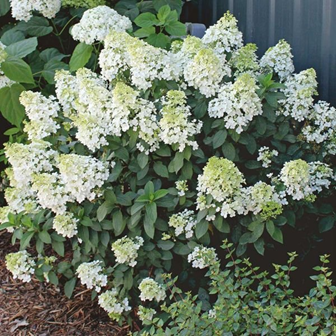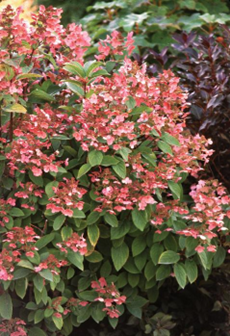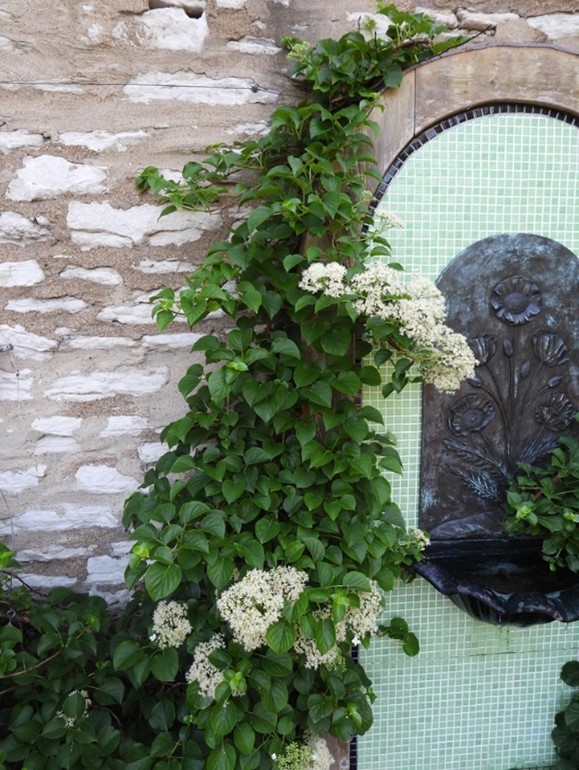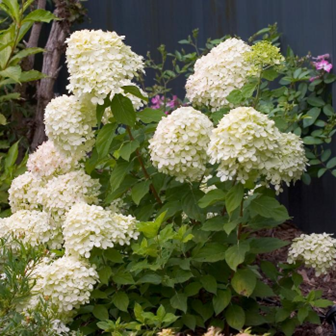Hydrangea Blooms!
By: Alyssum Flowers
A garden should have a mixture of annuals, perennials and woody ornamentals to provide seasonal interest, height and structure. Adding a few bushes or even a small tree will enhance the garden’s dimension as well as create habitat and protection for small birds, or butterflies that need to escape a sudden downpour. One lovely addition could be a hydrangea! Two species that are especially attractive to pollinators are Hydrangea paniculata (panicle) and H. anomala (lace cap).

H. paniculata “Little Lime.”
https://www.monrovia.com/little-lime-174-hardy-hydrangea.html
Panicle or Peegee hydrangeas are a favorite in the landscape due to their dependable Winter hardiness, versatile multi-stem habit and graceful arching branches. Depending upon the variety, it can grow from three to eight feet tall and spread about the same. Plant it for privacy, as a hedge, or a focal point in the garden. From July through September, each branch ends in panicles of lacey white petals. As temperatures drop in the Fall, the petals fade to creamy yellow or pink while the leaves turn bronze-yellow.
Another reason that the panicle hydrangea is popular is that it is drought tolerant and can grow in a range of soil textures. It can be planted in Zones four to eight and grows well in the shade but can take partial sun as well. Prune this species in the zfall as the flower buds develop on Spring growth. Very few pests or diseases affect this plant, yet it fits into many landscape spaces.
The climbing or lace cap hydrangea is a strong climber that can be grown on gazebos, arbors, or even brick walls. In its native range of the Himalayas, China, this deciduous climber can reach 60 feet, but is usually maintained at six to 10 feet. Grown without a tall support, it will form mounds and spread laterally. It climbs with twining branches as well as aerial rootlets that are visually appealing. The bark is reddish and sheds strips of red colored bark (exfoliating) which is stunning in the Winter. Fragrant, creamy white flowers appear in early Summer and last for several weeks in shade or partial sun. In late Fall the glossy green leaves eventually turn yellow, adding to seasonal beauty.

H. paniculata “Quick Fire” https://www.monrovia.com/quick-fire-174-hardy-hydrangea.html
It is also Winter hardy to Zone four but although it will grow in clay soil, it prefers a loamy, well drained soil texture. Climbing hydrangea requires strong support to keep it upright. It is mostly pest and disease free but is harder to establish than other hydrangea species. Despite some drawbacks it is an outstanding addition to a landscape and will attract many pollinators.
References
https://plants.ces.ncsu.edu/plants/hydrangea-paniculata/
https://www.missouribotanicalgarden.org/PlantFinder/PlantFinderDetails.aspx?taxonid=274441
https://landscapeplants.oregonstate.edu/plants/hydrangea-anomala-var-petiolaris

Hydrangea anomala https://www.missouribotanicalgarden.org/PlantFinder/PlantFinderDetails.aspx?taxonid=286935&isprofile=0&









